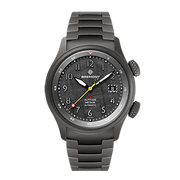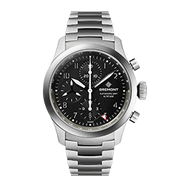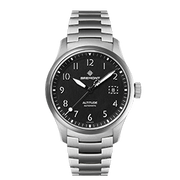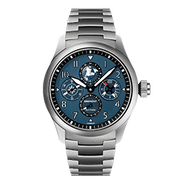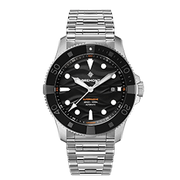In more recent years, the town began earning a new reputation, as the home of British watchmaking. Bremont Watch Company established their headquarters in Henley in 2005. The luxury watchmakers design and build beautiful mechanical timepieces near the banks of the River Thames and are focussed on reviving the watchmaking industry in Great Britain.

Now these two Henley organisations have joined forces, with Bremont appointed the first Official Timekeeper in Henley Royal Regatta’s history. Bremont will handcraft commemorative mechanical stopwatches for Henley Royal Regatta and develop a range of Regatta wristwatches.

TIMING ON THE THAMES
When the townspeople of Henley held a fair with an amateur rowing event in 1839, they launched what quickly became an annual sporting fixture. The Regatta received Royal Patronage in 1851 from HRH Prince Albert. Subsequently, each reigning monarch has been the event’s patron and the only breaks in its 178-year history were during the two world wars.
Initially an afternoon event, the Regatta now spans five days with over 280 races. Attracting participants from all over the world, Henley offers both an exceptional atmosphere and a unique challenge to rowers. Amateur oarsmen may compete against Olympic greats, in head to head knockout races, on Henley’s historic one mile and 550 yards Course.
Matthew Pinsent, Olympic rowing gold medallist and Steward, of Henley Royal Regatta, explains the Regatta’s appeal: “Henley is special and exists with rules and historical setting all of its own. We like to think that it is the pre-eminent side by side race in the world - partly because of its history and partly because of its appeal from internationals through clubs to schools and juniors, all testing themselves on the same Course the same days of summer.”

As the wide River Thames meanders through the town, it divides the two counties that demarcate the race starting stations: Buckinghamshire on the north bank, and Berkshire on the south. Following tradition, races begin with shouted instructions of ‘Attention’, followed by ‘Go’ and the dropping of a flag.
The oarsmen and women power narrow racing shells down the Course, which is marked out with potentially perilous wooden posts and booms. An Umpire and Stewards follow behind in a wooden motor launch, using handheld stopwatches to check progress at marker points along the Course. Once the exhausted crews have passed the Finish Line, both teams give a traditional three cheers for their opponents.
What differentiates Henley from other regattas is the colourful and noisy ambience of Henley’s social scene. An essential fixture on the summer social calendar, over 300,000 visitors descend to enjoy the atmosphere and cheer on the participants. Henley’s long held customs extend to spectators, with men adorned in colourful rowing club blazers and boater hats, and ladies requested to keep hemlines below the knee in the Stewards' Enclosure. Reminiscent of an Edwardian summer scene, the event has changed little since the nineteenth century, as if time stood still on the banks of the Thames.
Enclosures, grandstands and every available space along the riverbank are packed with onlookers feasting on picnics and quaffing champagne. Pleasure craft on the river provide a unique vantage point with smaller boats moored right alongside the Course, mere metres from the rowers. Surrounded by cheering spectators in such close proximity, competing at Henley is an unforgettable experience for the rowers.

The river has always been at the heart of life in the historic market town of Henley-on-Thames, with ornate gabled buildings with pretty red roofs clustered along its banks. Surrounded by lush green woodland and rolling pasture, the town is considered one of England’s most beautiful.

Whilst the social side of the Regatta provides a draw to Henley, the competition on the water is serious. For Regatta entrants, Henley involves lengthy preparation, the sheer effort of which is etched on their faces at the end of the Course, whether basking in the relief of victory or the distress of defeat. Nick says, “At Bremont, we love to champion those who push themselves to the limits and we build our timepieces to withstand those extremes on the wearer’s wrist. ‘Tested Beyond Endurance’ is a strong part of the Bremont ethos. We have the utmost admiration for the Regatta entrants and their extreme physical effort to take victory on the Henley Course.”

TIMING MECHANISMS
Competitors at Henley Royal Regatta are racing their opponents, but they are also racing the clock. Timekeeper Stewards were first appointed in 1906 but the straight course used today was set in 1924, enabling times to be truly comparable. Matthew Pinsent explains, “The records are all to the nearest second and still done with Steward thumbs on stopwatch buttons in the Umpire’s launch. I think the crews appreciate the history and it’s a big moment when you get to have your name go in the record section at the back of the programme.”
First developed in the 17th century, the stopwatch remains vital equipment at sporting events today. Our need to measure time elapsed was first solved by English horologist Samuel Watson. He invented a ‘Physicians Pulse Clock’ in 1690, with a second hand and a lever to stop the movement, enabling doctors to measure a patient’s pulse. The handheld mechanical device we recognise today emerged in the 19th century, and has since changed very little in design.
To honour Henley’s traditional use of handheld timing, Bremont will handcraft a beautiful commemorative mechanical stopwatch for the 2017 Regatta.



TIMING TRADITION
Whilst the word Henley conjures up images of the Regatta, the name Bremont has become synonymous with mechanical. At their Henley headquarters, Bremont’s watchmakers carefully construct highly accurate luxury mechanical timepieces. Nick English explains the enduring appeal: “There’s a wonderful longevity with mechanical. The intricacy of the engineering and the high level of craftsmanship required make a mechanical timepiece a small work of art.”
For more than a century, Henley Royal Regatta has relied on handheld timing. For Bremont, their mechanical Henley Royal Regatta stopwatch will honour this and the other customs unique to one of England’s most renowned and historic sporting events. Nick concludes, “Henley Royal Regatta has a phenomenal heritage that ties in beautifully to our core values at Bremont. The event is so quintessentially British and as Official Timekeeper, we are delighted to celebrate Henley’s long-held traditions.”









